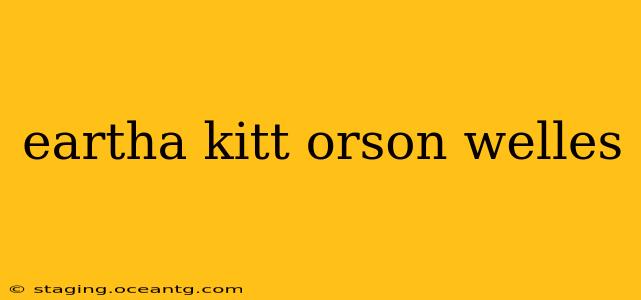Eartha Kitt and Orson Welles, two titans of their respective fields, shared a brief but intensely memorable professional relationship, marked by both creative sparks and undeniable friction. Their collaboration, primarily centered around Welles's ambitious and ultimately troubled stage production of Moby Dick, reveals fascinating insights into the personalities and working styles of these two larger-than-life figures. This exploration delves into their professional partnership, exploring the highs and lows of their interactions.
What was Eartha Kitt's role in Orson Welles' Moby Dick?
Eartha Kitt's role in Orson Welles's theatrical adaptation of Moby Dick was that of Queequeg's mother. While a relatively small part compared to the overall production, Kitt's powerful stage presence and unique vocal abilities were intended to add a captivating element to the already complex and visually stunning spectacle that Welles envisioned. Unfortunately, the production was plagued with issues, limiting the full impact of her performance. Her contribution, however, remains a noteworthy footnote in the production's turbulent history.
What happened between Eartha Kitt and Orson Welles?
The relationship between Kitt and Welles was complex and reportedly fraught with tension. While precise details of their disagreements remain somewhat shrouded in anecdote, accounts suggest clashes stemmed from creative differences and contrasting working styles. Welles, known for his improvisational and demanding approach to directing, likely clashed with Kitt's own strong artistic sensibilities and independent spirit. The inherent challenges of adapting Moby Dick for the stage, coupled with production delays and financial constraints, likely exacerbated pre-existing tensions between the two.
Did Eartha Kitt and Orson Welles ever work together again?
To the best of current knowledge, Eartha Kitt and Orson Welles did not collaborate on any other projects after Moby Dick. The experience appears to have been a singular and ultimately strained encounter, leaving no further documented instances of professional interaction between the two.
How did Orson Welles direct Eartha Kitt?
Unfortunately, specific details about Welles's directorial approach towards Kitt during Moby Dick are scarce. However, based on Welles's overall directorial style, it's reasonable to assume he offered a mixture of guidance and freedom. He was known for pushing actors to explore their full potential, demanding both emotional depth and physical commitment. Yet, his methods were often highly improvisational and demanding, requiring actors to be flexible and adaptable. Given Kitt’s own forceful personality, their collaboration undoubtedly involved a degree of creative give-and-take, even if fraught with tension.
What was the impact of their collaboration?
The impact of Eartha Kitt and Orson Welles’s collaboration remains a subject of debate. While their joint venture on Moby Dick didn't result in a widely acclaimed success due to the production's numerous issues, it still remains a fascinating intersection of two extraordinary talents. For Kitt, it offers a glimpse into her range and willingness to take on unconventional roles. For Welles, it highlights the challenges and ultimately the incompleteness of his ambitious vision. The collaboration underscores the complexities and inherent tensions that can arise even when exceptionally gifted artists come together.
Conclusion: A Legacy of Contrast
The brief intersection of Eartha Kitt and Orson Welles's careers, while marked by professional friction, serves as a compelling case study in artistic collaboration. Their interaction, primarily defined by their involvement in the challenging production of Moby Dick, leaves behind a legacy of both creative potential and the inherent difficulties of realizing grand visions. While the full story of their interactions remains partially untold, it adds a rich, albeit somewhat turbulent, layer to the biographies of these two legendary performers.
